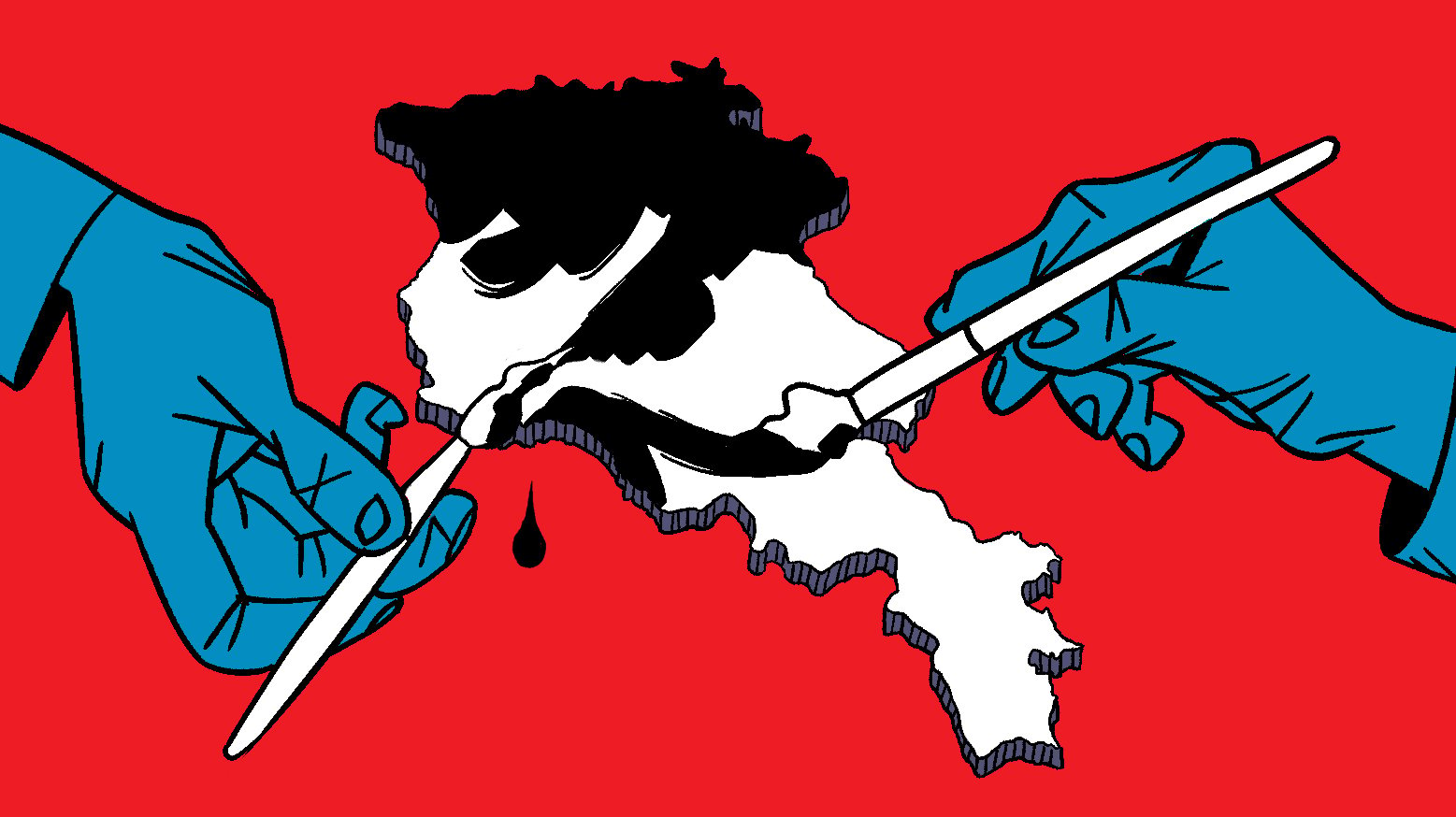On February 24, on the eve of the war that began with Russia’s attack on Ukraine, Russia announced its recognition of the Donetsk and Luhansk People’s Republics.
After around half a year into the war, the only official reaction of the Armenian authorities was the non-recognition of the independence of the DPR and LPR as recognized by Russia.
Despite the relatively silent reaction of official Yerevan and the general circles of society, in the first months of the Russian-Ukrainian war, various circles carried out propaganda against Armenia, trying to create the impression that the country and its population support Russia in its war.
Along with fake news and conspiracy theories, a number of propaganda narratives were spread, which were either old and adapted to new situations, or were created in the context of the war itself.
Propaganda narratives
“The Russian army” from the Kievyan bridge
On February 27, just three days after the Russian attack on Ukraine, the first propaganda video was shared on the Internet, which quickly gained hundreds of thousands of views. In the video, a huge banner with the inscription “Армия России” was hanging from the Kievyan Bridge in Yerevan.
The first comments on social networks were that the video was fake. However, as media.am later wrote, the video was recorded in a few minutes, a group of people hung the poster and filmed it. The whole process took no more than ten minutes.
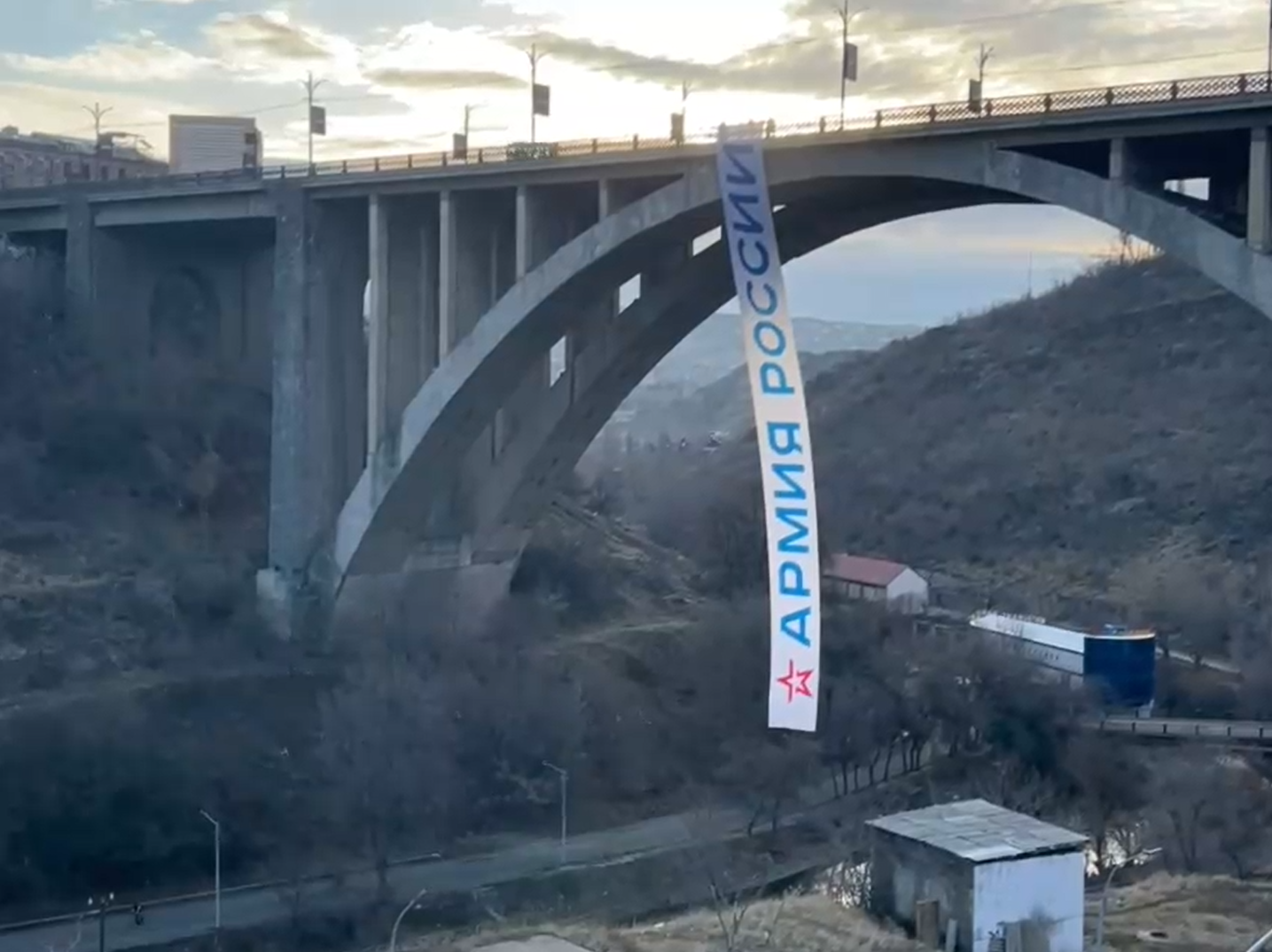
The video was especially popular on the pages of several social network users, including the head of the Turkey bureau of the famous Middle East Eye, Ragip Soylu, and Belarusian Нехта (Nekhta). Soylu deleted the post after some time.
As for Нехта, this relatively young media outlet became famous during the anti-establishment movement in Belarus, but after Russia’s attack on Ukraine, it has not once stood out for spreading propaganda materials.
The original source of the video remained unknown, but it was most likely spread by Armenian Russian-speaking Telegram channels, which have been carrying out active pro-Russian propaganda since the beginning of the war.
“Operation Z”
In a village in the Shirak region, farmers cut out Z’s in the fields in support of Russia’s war. The video was shot by the Russian news agency Sputnik Armenia.
Despite the fact that media and social network users tried to present similar actions as proof of Armenia’s support for Russia, and those videos were actively distributed on the Internet and gathered hundreds of thousands of views, none of these actions received much public support.
Another such incident was at Gyumri school No. 19, where the students, as it turned out later, were forced to line up and take pictures forming the letter Z in support of Russia. The school operates next to the Russian military base in Gyumri, and children of military base employees, military personnel, and Russian diplomats, as well as local Armenian children, study here. The school is financed by the Ministry of Defense of Russia, it is guided by the legislation of the Russian Federation.
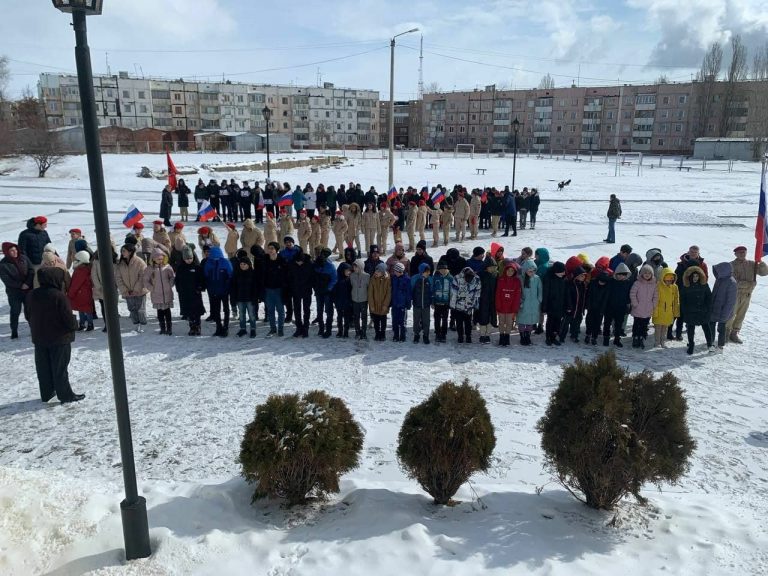
A similar protest-video was also shared from Yerevan’s Victory Park (the park symbolizes the victory of the Soviet Union in the Second World War). At least it was presented as a video recorded in Victory Park. The video was shot at night and edited. The letters Z and V and the surroundings of the city follow each other in the video, and the statue of Mother Armenia or the city walls of Yerevan are not shown at the same time. This does not provide an opportunity to claim that the video is fake or to confirm that the video was indeed filmed in Victory Park in Yerevan. However, it is clear that, as in the case of the Kievyan bridge, this video was shot for propaganda purposes, whether in Yerevan or elsewhere.
As a rule, all of these videos were initially distributed on social networks, in particular, they were distributed by pro-Russian Telegram channels, and soon they appeared at the center of attention of Russian propagandists, Margarita Simonyan, as well as Russian state TV channels and websites.
Demonstrations in support of Russia
In Armenia, since the beginning of the war, several gatherings and protests were organized in support of both Ukraine and Russia.
The largest-scale demonstration in support of Russia was organized by the efforts of the leader of the “Alliance” party, former deputy of the National Assembly Tigran Urikhanyan, and the Communist Party of Armenia. Urikhanyan regularly announces the need to create a common state with Russia.
As a rule, these demonstrations spread this very narrative of deeper integration with Russia and expressed support for Putin in the war in Ukraine. The participants of these demonstrations spread Russian propaganda narratives about Ukraine about Ukrainian Nazism and waved banners with the Russian Z and V. Such protests were organized mainly in March-April.
Russian state media and a number of Armenian websites and TV channels actively covered these protests.
Demonstrations in support of Ukraine went unnoticed
Although pro-Russian and anti-war or pro-Ukraine protests had an almost equal number of participants, the first, unlike the second, was spread at a high speed on social networks and Russian state media. Meanwhile, protests supporting Ukraine remained in the shadows.
Similar protests in support of Ukraine were organized by the Embassy of Ukraine in Armenia, the European Party of Armenia, and a group of young people.
Disinformation
Armenian SU-30s were not in Ukraine
At the end of March, Azerbaijani Haber Global operating in Turkey, referring to Turkish intelligence data, claimed that the SU-30 fighter jets acquired by Armenia in recent years were sent to Russia, and from there to Ukraine.
This unconfirmed information was also spread by Ukrainian media with a large audience, as well as by a number of users with a large number of followers. Despite the speedy denials of the Ministry of Defense and the Ministry of Foreign Affairs, the news spread in the Azerbaijani, Turkish and international media until the Ministry of Defense of Armenia invited the military attachés accredited in the country to the military base of the Ministry of Defense of the Republic of Armenia, where the fighter jets were stationed.
The Ministry of Defense also published photos from the visit of the military attachés checking the “presence” of the fighter jets. Even after the denial, however, the claims that Armenia sent the SUs to Ukraine continued.
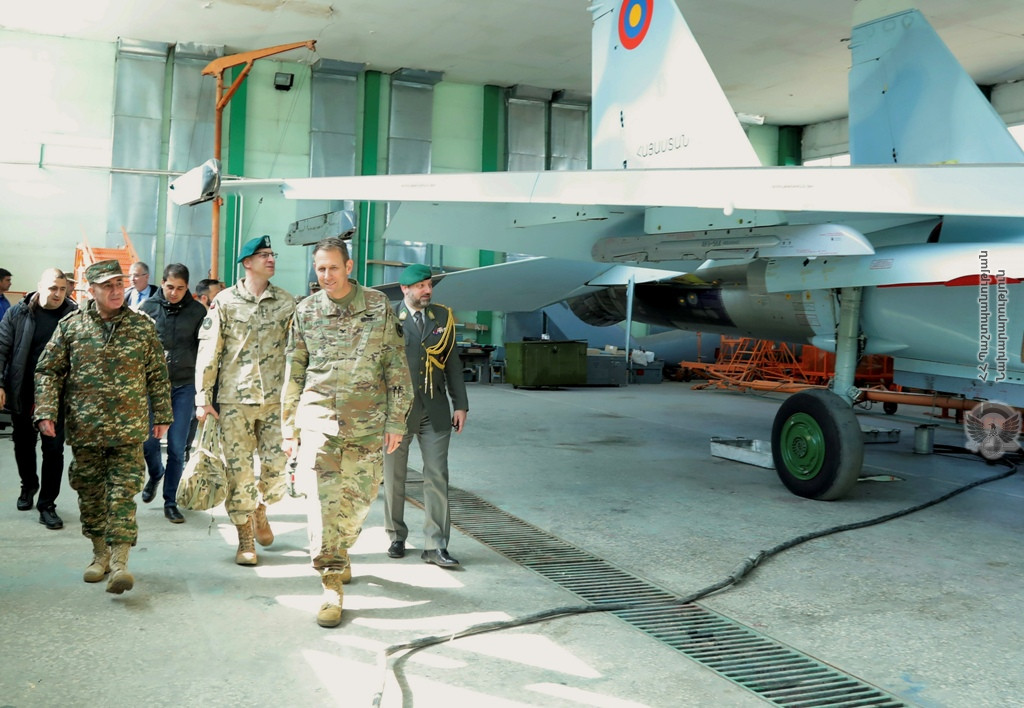
Russian peacekeepers “departed” to Ukraine or Armenia as a “transit” for mercenaries
Again, information was spread from Azerbaijani and Turkish sources that the peacekeepers stationed in Nagorno-Karabakh were transferred to Ukraine to fight. As evidence, a convoy of Russian military vehicles passing through the Lachin Corridor was shown.
Although the video is real, it is in no way proof of the movement of Russian troops or their withdrawal from Armenia. Military planes from Armenia to Russia do not carry out a regular or large number of flights, unlike, for example, flights from Turkey or Israel to Azerbaijan in 2020, which, according to various sources, carried weapons and ammunition on the one hand, and mercenaries on the other.
In almost the same way, following the information about the mercenaries transported from Syria to Azerbaijan through Turkey during the second Artsakh war, the Azerbaijani and Turkish media presented Armenia as a “transit” country for mercenaries moving from Syria to Russia and then to Ukraine.
Unlike the information about Syrian mercenaries, the narrative of Armenian mercenaries did not find any justification, except for two flights from Latakia to Erebuni military base, and from there to Russia.
In the case of Azerbaijan, however, a number of international news outlets found evidence of their travel and participation in the war, even interviewing enlisted Syrians.
In this context, on various occasions, the users of social networks recalled another propaganda narrative spread in the Artsakh war, about the fighters of the Kurdish Workers’ Party of Iraq, the PKK, fighting with the Armenian soldiers. In the case of the Russian-Ukrainian war, according to popular narratives, the PKK troops are fighting on the side of the Russian army.
It should be noted that there is no evidence of the presence of Kurdish troops either in Nagorno-Karabakh or in Russia, and in 2020, photographs of the Yezidi population of Armenia and Yezidi servicemen or volunteers were distributed as evidence.
Who is spreading the propaganda narratives?
Social network influencers and Azerbaijani lobbyists
Luke Coffey, a well-known Azerbaijani lobbyist, has been promoting the narrative that Armenia is a supporter of Russia and therefore deserves sanctions on the social network Twitter since the start of the war. Coffey shared posts on a similar topic, especially in the background of news about Armenia’s provision of relocation opportunities to Russian IT companies and individuals. Michael Doran, another well-known Azerbaijani lobbyist, campaigned against Armenia on topics related to the Ukrainian war.
Another narrative that “influencers” of social networks regularly spread is the identification of Ukraine-Russia and Armenia-Azerbaijan conflicts. Thus, along with the struggle for Ukraine’s territorial integrity, Azerbaijan’s lobbyist Brenda Shaffer insisted that the West should support Azerbaijan in the same way.
These narratives, in addition to Brenda Shaffer, were also spread by political scientist, Taras Kuzio and others, who in one way or another are connected with Azerbaijani lobbying organizations.
“Official” and unofficial Ukraine
There are a number of examples of propaganda against Armenia in the Ukrainian press, but from time-to-time Ukrainian officials also join this topic. In their case, the main topic is Azerbaijan’s possible escalation in Nagorno-Karabakh in order to open a “second front” for Russia.
Thus, the Secretary of the Security Council of Ukraine, Oleksiy Danilov, announced at the end of March that Azerbaijan may start a war against Armenia. These narratives were also spread on social networks with different interpretations.
Against the backdrop of tension on the Artsakh-Azerbaijani border, the Twitter account of the Verkhovna Rada of Ukraine seemed to “endorse” a possible conflict. After the reactions and the intervention of the Armenian Embassy in Ukraine, the tweet was removed.
Oleksandr Sherba, former Ambassador of Ukraine to Austria, shared a video of a demonstration held in Yerevan in support of Russia on his Twitter account. Before the tweet was removed after being criticized by Armenian users, the video already had close to a hundred thousand views. Not long after the anti-war action in Yerevan, Sherba shared a video again, giving thanks and writing that “not all of Armenia is on Putin’s side.” This video received much fewer views and shares than the first one.
Russian channels
The narrative that Armenia is a supporter of Russia is the first to be spread by Russian TV channels, covering protests unknown to the majority of the population of Armenia. The Russian media are quite active in covering the narrative spreading in Armenia about “biolaboratories” and the protests organized on these topics. At the same time, this topic was also delicately connected with Ukraine, which Russia also accuses of preparing biological weapons in biolaboratories.
The evening protest with Zs and demonstrations of the Communist Party etc. appeared on the air of the first Russian channel. State online media also actively spread this type of news.
Telegram
Russian-language Telegram channels are quite popular in Armenia, some of which are Armenian. Many of these channels, with several tens of thousands or several thousands of followers, are seriously engaged in spreading Russian propaganda narratives.
In some cases, alongside anonymous channels, there are, for example, personal channels of famous Russian activist Mika Badalyan and journalist Aram Gaprelyanov, in which the latter actively spread Russian propaganda narratives.
Mika Badalyan was detained in April for “giving a false report about terrorism” after he wrote on his Telegram channel that terrorist attacks are possible in Armenia in order to create a state of emergency. Badalyan presented “suppression of anti-Russian demonstrations” as the reason for his arrest and almost two months in detention. Badalyan gave the same comment after being detained on July 29.
Badalyan is also one of the active promoters of the topic of biolaboratories in Armenia. He also spread false information, stating that because of those laboratories, several hundred people in Armenia have already been infected with monkeypox.
Even after the war, Aram Gabrelyanov often shares posts about Ukrainian “Nazis,” and Armenia standing next to Russia in any war.
In parallel, many channels with a smaller audience share these posts or create their own, similar content about supporting Russia.
A similar channel, Армянский_Z_Дворик, was created in the spring of last year, has about 7,500 followers, and deals mainly with Russian propaganda. Examining the statistics of this channel’s posts, it appears that it mainly shares posts from the channels Mika Badalyan, Армения Сенсации-Reconquista, МИГ INFO, and ArmLine -Новости Z. At the same time, these channels actively share Армянский_Z_Дворик’s posts.
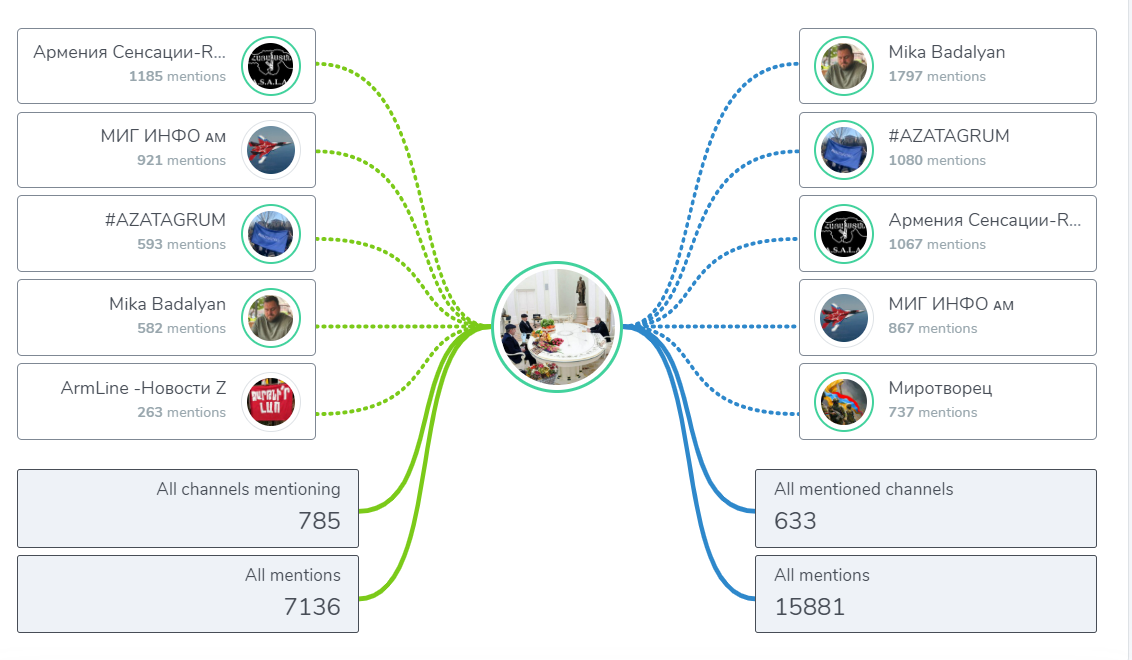
The same picture applies to channels with the same content. Although there is no evidence that these channels are managed from the same place or by the same group, in addition to sharing each other’s posts, these channels also share posts with the same content or propaganda.
Ani Avetisyan
